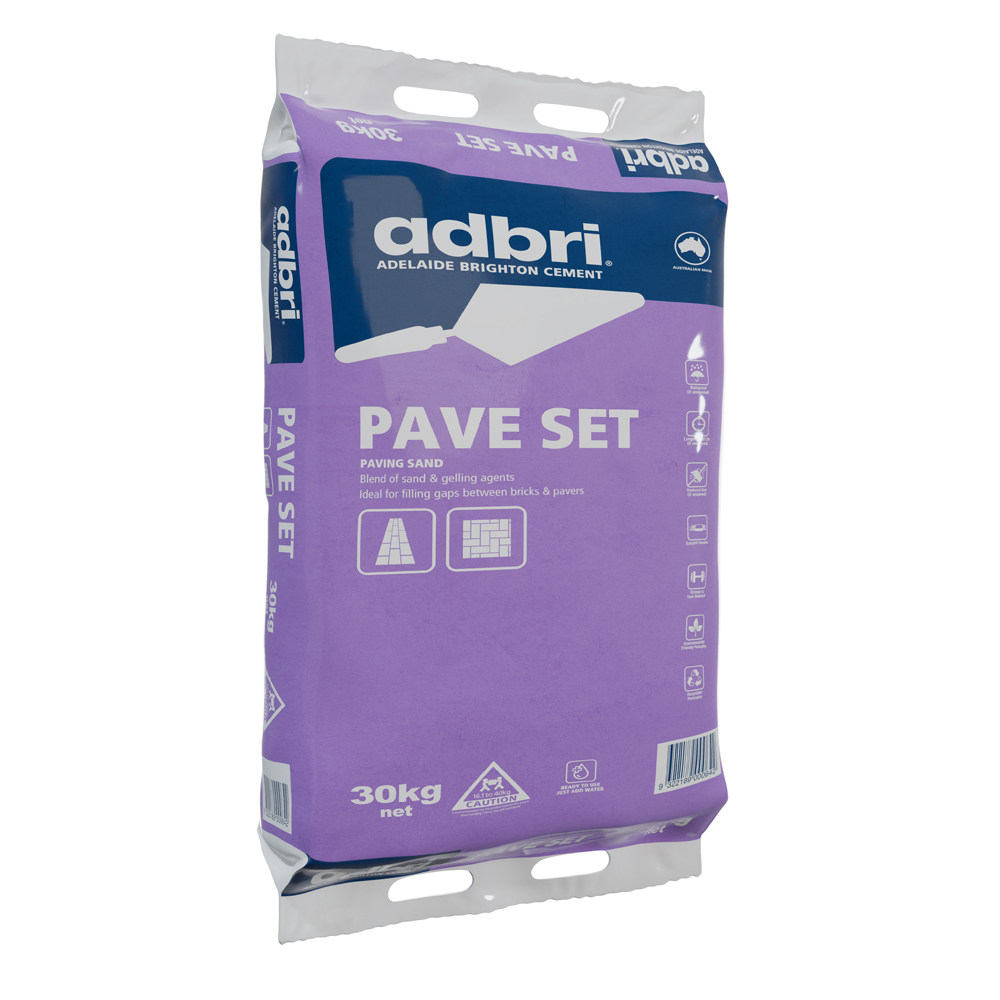Paving

Materials & Equipment – Essential
| • Adbri Cement Pave Set (20 kg or 30 kg bag) | • Concrete, timber or masonry edging restraint | • Sub-base (eg road base) |
| • Bedding sand | • Pavers | • Timber rails x 2 |
| • Screed rail (eg timber/aluminium) | • Spade | • Metal prong rake |
| • String line | • Tape measure | • Wooden stakes |
| • Spirit level | • Vibrating plate compactor (rubber mallet and timber board for smaller jobs) |
Materials & Equipment – Optional
| • Cutting equipment (hammer and bolster chisel/masonry saw) |
Safety
When working with Pave Set wear protective clothing, strong boots, gloves, and eye protection.
Manual handling of bag products without due care and attention may result in personal injury. Unless you have been trained in manual handling methods it is suggested that you share the load with another person.
For more safety information refer to the Pave Set safety data sheet.
Material quantities
Best practice is to incorporate a minimum 100 mm layer of sub-base in the paving structure, especially if the sub-grade is unstable. For more heavy duty areas such as driveways, please consult a qualified engineer.
Tonnage of sub-base required, example calculation:
- 10 m2 area compacted to 100 mm (0.1 m) thick.
- 10 m2 x 0.1 m = 1 m3 of sub-base.
- 1 m3 x 1.7 tonne/m3 (estimated compacted bulk density of sub-base)
- = 1.7 tonnes of sub-base required for 10 m2 area compacted to 100 mm thick.
30 mm layer of bedding sand, 10 m2 area will require:
- 10 m2 area screeded to 30 mm (0.03 m) thick.
- 10 m2 x 0.03 m = 0.3 m3 of bedding sand.
- 0.3 m3 x 1.5 tonne/m3 (estimated bulk density of paving sand)
- = 0.45 tonnes of bedding sand required for 10 m2 area screeded to 30 mm thick.
To help customers estimate the number of pavers and Pave Set bags required, check out our estimator tool {link}. Simply confirm paver dimensions and total area to be laid.
Site preparation
- It is vital to prepare the area properly to achieve a quality result.
- Dig out the area to be paved factoring in depth of sub-base, bedding sand, and paver thickness (minus 10 mm for compaction). Ensure excavation is even and ground level.
- Place string lines around the area to be paved and slope them to ensure water runs off paving and away from buildings. A drop of 20 mm per metre is recommended.
- If paving against buildings, lay pavers more than 25 mm below damp course and air vents should not be covered.
- Place the sub-base, rake even, and compact using either a vibrating plate or timber board and rubber mallet. Sub-base should be laid and compacted in 50 mm increments.
- Spread the bedding sand evenly over the area and rake to 40 mm depth. A coarse well graded inland sand is ideal (DO NOT USE beach or fine sand).
- Position the timber rails along the sides of the area and level the sand using the screed rail.
- Ensure timber rails are sloped to facilitate 20 mm per metre fall as discussed above.
- Once level, remove timber rails, fill in gaps with bedding sand, and even off.
Paver placement
- After selecting a pattern, lay pavers evenly on the sand keeping them square with the starting edge and leave a gap of around 2-3 mm between each one.
- Once full sized pavers are laid, measure gaps in the paved area and cut part-sized sections accordingly.
- Pavers can be cut using a hammer and bolster chisel or masonry saw.
Paver edging
- To ensure pavers do not move, it is essential to construct some form of edging around the paved area.
- Edge restraints can include timber, Concrete®, or masonry.
- Install edging approximately 10 mm below the level of the pavers to allow for compaction.
Applying Pave Set
Pave Set works when the sufficiently compacted sand particles interlock between themselves and the vertical sides of the paving units. To maximise sand particle interlock, the gap width between the paving units should be 2-3 mm.
Vertical sides of the pavers should be clear of debris and flush. Pave Set will not work on:
- V-shaped joints.
- Paver chamfers.
- Joint widths greater than 5 mm.
- It is recommended to trial a small test area first with Pave Set to ensure the product is compatible with the paver selection.
- Ensure pavers are dry and clean of any other loose material such as dirt or sand.
- Spread Pave Set evenly over the pavers and sweep into the joints. DO NOT sweep over long distances as this can cause segregation of the gelling agent.
- Using a vibrating plate or rubber mallet and piece of timber, compact the pavers by approximately 10 mm. Apply more Pave Set into the joints and compact the area again to ensure full compression of the product.
- Sweep up excess Pave Set from the surface of the pavers to prevent possible staining or discolouration. Ensure all Pave Set is removed from chamfered or rounded top edges.
- Apply a fine mist spray to completely saturate the Pave Set, ensuring full depth penetration of the product (subsequent applications may be required). Be careful not to dislodge the Pave Set out of the gaps during this process.
- Dry cure the Pave Set for at least 2 days prior to sweeping or allowing heavy traffic on the area. This drying process is essential to allow the product to gel sufficiently.
Pave Set: Important things to remember
- DO NOT apply Pave Set when rain or high winds are expected within 2 to 3 days of application.
- DO NOT use Pave Set around swimming pools, as constant wetting and drying cycles reduce the life of the product.
- DO NOT use Pave Set on inclines greater than 1:10 (10 cm fall over 1 m distance) as water runoff may reduce gelling characteristics.
- DO NOT use Pave Set in joints greater than 5 mm as limited particle interlocking can be achieved.
- DO NOT use Pave Set in “V-shaped” joints or chamfered pavers as limited interlocking can be achieved.
- DO NOT use Pave Set with cobblestones as the gaps are too large to achieve sufficient particle interlocking.
- DO NOT use Pave Set on a rigid base (e.g. concrete) as lack of compaction and drainage will adversely affect gelling and particle interlock.
- Pave Set WILL NOT go hard. It will gel to a firm surface when dry.
- During periods of wet weather or high humidity, Pave Set® may take several days to gel.
